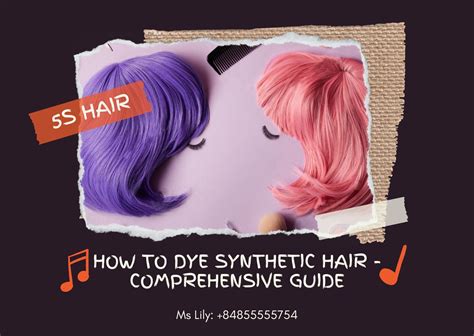Introduction
In today’s beauty landscape, synthetic hair dye has become a staple for countless individuals seeking to transform their appearance and express their unique style. From vibrant hues to subtle shades, the vast array of synthetic hair dye options available empowers consumers to experiment with their look and achieve their desired results.

Types of Synthetic Hair Dye
Synthetic hair dyes can be broadly classified into two main categories: permanent and semi-permanent.
Permanent Hair Dye:
- Penetrates the hair shaft and alters its natural pigment
- Lasts for several weeks or months, gradually fading over time
- Requires professional application or extensive home care
Semi-Permanent Hair Dye:
- Deposits color molecules on the hair shaft without altering its natural pigment
- Lasts for several washes, typically fading within 6-8 weeks
- Can be applied at home without professional assistance
Top Synthetic Hair Dye Products
The market for synthetic hair dye is highly competitive, with numerous brands vying for consumer attention. According to a report by Allied Market Research, the global hair dye market is projected to reach a staggering $20.7 billion by 2031, with synthetic hair dye accounting for a significant share.
Among the top synthetic hair dye brands are:
| Brand | Known For |
|---|---|
| L’Oréal Paris | Wide range of colors, advanced formulas |
| Garnier | Affordable options, natural-looking results |
| Clairol | Professional-grade products, vibrant shades |
| Crazy Color | Bold, unconventional hues |
| Arctic Fox | Vegan, cruelty-free dyes with intense pigmentation |
Trends in Synthetic Hair Dye
The synthetic hair dye industry is constantly evolving, with new trends emerging to cater to evolving consumer preferences.
Bold and Vibrant Hues:
- Unconventional shades, such as electric blue, neon pink, and emerald green, are gaining popularity.
- These hues allow individuals to make a statement and express their creativity.
Natural-Looking Colors:
- Subtle shades, such as caramel, golden blonde, and chestnut brown, continue to be in high demand.
- Consumers seek to enhance their natural hair color without drastic transformations.
Hair Dye Techniques:
- Techniques like balayage, ombré, and dip-dye create gradual color transitions for a more natural-looking effect.
- These techniques allow for a wider range of color combinations and customization options.
Benefits of Synthetic Hair Dye
Synthetic hair dye offers a myriad of benefits to consumers:
- Versatile: Available in countless colors and shades, enabling customization to suit individual preferences.
- Affordability: Compared to professional hair color services, synthetic hair dyes offer a cost-effective alternative.
- Convenience: Home hair dye kits are user-friendly and allow for convenient application at home.
- Self-Expression: Synthetic hair dye empowers individuals to explore their creativity and express themselves through color.
Matters to Consider When Choosing Synthetic Hair Dye
Choosing the right synthetic hair dye is crucial to achieving desired results. Key matters to consider include:
- Desired Color: Determine the specific hue and shade you wish to achieve.
- Hair Type: Different hair types require specific dye formulations. Consult a hairstylist for guidance.
- Skin Tone: Certain hair dye colors complement specific skin tones, creating a harmonious overall look.
- Dye Method: Permanent hair dyes require professional application, while semi-permanent dyes can be applied at home.
- Ingredients: Be aware of any potential allergens or sensitivities to ingredients in hair dyes.
Safety Tips for Using Synthetic Hair Dye
While synthetic hair dye is generally safe for use, it is essential to exercise caution to minimize potential risks.
- Follow Instructions Carefully: Read and adhere to the manufacturer’s instructions thoroughly.
- Perform a Skin Test: Test a small amount of dye on a secluded area of skin to check for any allergic reactions.
- Protect Skin and Eyes: Wear gloves and protective eyewear during application to prevent staining and irritation.
- Ventilate the Area: Apply hair dye in a well-ventilated area to avoid inhaling harmful fumes.
- Avoid Overuse: Excessive use of hair dye can damage hair and cause breakage.
How to Care for Hair Treated with Synthetic Hair Dye
Proper care is essential to maintain the vibrancy and health of hair treated with synthetic hair dye.
- Use Color-Protecting Shampoo and Conditioner: Specially formulated products help preserve color and prevent fading.
- Limit Heat Styling: Heat can damage hair and contribute to color loss. Use heat protectants when styling.
- Avoid Chlorine and Saltwater: Chlorine and saltwater can strip hair of color. Rinse hair thoroughly after swimming.
- Deep Condition Regularly: Deep conditioning treatments nourish and restore hair, preventing dryness and damage.
Creative Applications of Synthetic Hair Dye
Beyond its traditional use for hair coloring, synthetic hair dye has sparked innovative applications in other industries.
- Textile Dyeing: Synthetic hair dyes are employed in the textile industry to create vibrant and long-lasting colors on fabrics.
- Arts and Crafts: Artists use synthetic hair dyes to create unique and colorful works of art on various surfaces.
- Cosplay and Costume Design: Cosplayers and costume designers utilize synthetic hair dyes to achieve realistic and eye-catching hair colors for their costumes.
Conclusion
Synthetic hair dye remains a popular and versatile tool for individuals seeking to transform their appearance and express their unique style. With countless colors, trends, and applications available, consumers are empowered to experiment and create the desired results. By considering the matters outlined in this guide, individuals can choose the right synthetic hair dye and enjoy its benefits while prioritizing safety and maintaining healthy hair.
